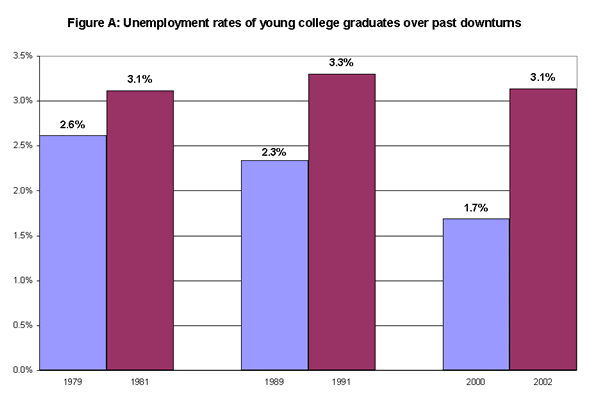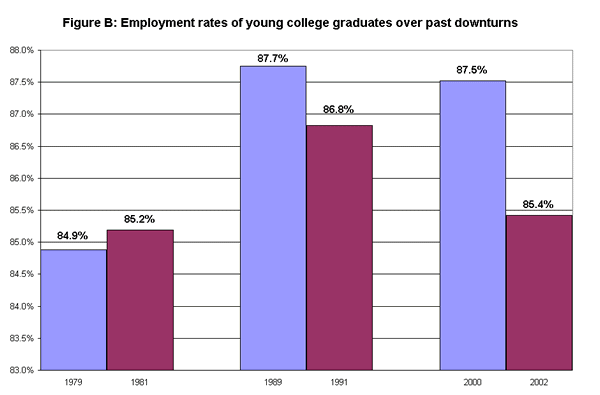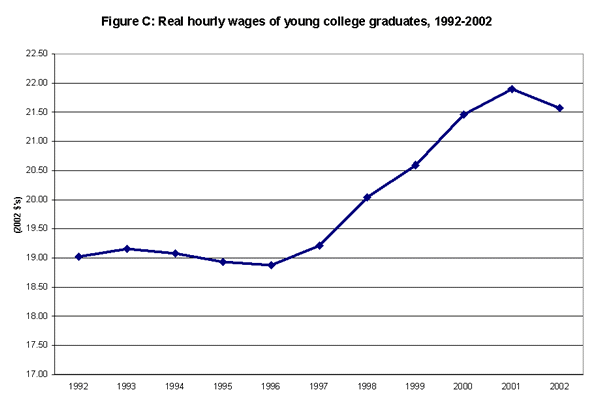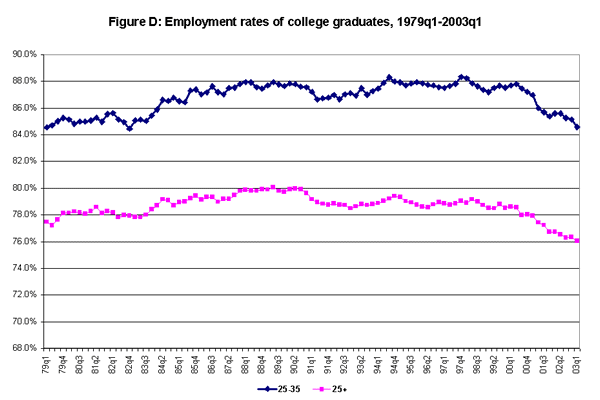Snapshot for May 13, 2003.
The job market for young college graduates
A difficult start amidst a jobless recovery
Millions of young college graduates currently are preparing to enter the job market. Unfortunately, they will find a particularly weak labor market awaiting them.
The recession that began in March 2001 has evolved into a jobless recovery: while the economy is expanding, growth is too slow to lower the unemployment rate or reverse contracting payrolls. In addition, the roots of this recession-the bursting of bubbles in financial and information technology sectors-have led to a tougher economy for more highly educated workers relative to earlier downturns (though the early 1990s recession was similar in this regard). The result is historically large declines in employment opportunities for new graduates.
(Each of the figures below focus on persons age 25-35 who have at least a four-year college degree.)
Unemployment
Over the first two downturns shown in Figure A, unemployment rises in the expected manner when the economy hits a recession. But in the current downturn, the increase for young college graduates was larger than in past cases, as unemployment grew from an historical low point of 1.7% in 2000 to 3.1% in 2002. Despite the fact that the overall unemployment rate remains lower than in past recessions, the 2002 rate for young college graduates is about the same, implying that this group has been disproportionately hurt by the weak labor market.

Employment
Though employment rates (the share of the population with a job) tend to get less attention than unemployment rates, they can be very informative in a period like the current one, when pervasive labor market weakness is leading some potential workers to give up their job search. Since they are not seeking work, such persons will not be counted among the unemployed, but they will show up in lower employment rates. When this occurs, employment rates arguably provide a better indicator of the extent of job-market opportunity than unemployment.

Here again, the current downturn posts the largest decline in the share of the young college graduate population with jobs (see Figure B). In the much deeper recession of the early 1980s, employment rates of young college grads actually edged up a bit, as that downturn posed greater problems for blue-collar workers. While blue-collar workers continue to be hit hard by recessions, the last two downturns have reached white-collar workers as well, with the decline in employment particularly pronounced in the current case.
Real wages
Figure C shows real hourly wage rates for young college graduates between 1992 and 2002. The white-collar woes coming out of the early 1990s recession resulted in flat real wage growth through the middle of the decade. Eventually, though, the job market for young college grads heated up considerably and the momentum carried real wage growth through the recessionary year of 2001. But lack of demand for these workers (as shown in the prior two figures) has caught up to real wage growth, which, after rising at an annual rate of 3.0% in the 1995-2001 period, fell to a 1.5% annual rate in the 2001-2002 period.

Employment rates over the long-term
Figure D compares the quarterly employment rates (seasonally adjusted) of young college graduates, age 25-35, to all college grads age 25 and up. The young college grads have higher employment rates, on average, as they are the least likely to have left the labor force due to retirement or the starting of a family. While some response to the business cycle can be seen in the figure-particularly in the early 1990s recession-the decline in employment rates in this downturn stands out as the largest in over two decades. For the young college grads, the employment rate as of the first quarter of this year is about equal to the low point in the early 1980s. For all college grads, the series is at a new low.

Once the economy turns around, demand for these workers will surely return. In the long run, the U.S. labor market has handily absorbed the ever-increasing share of college graduates it produces. And even in these hard times, college grads have lower unemployment rates and higher wage rates than those without advanced education. But the current downturn has clearly created an inhospitable labor market environment for those starting out, even those with advanced educational credentials.
Sources: Figures 1, 2, and 4: Author’s analysis of CPS data; Figure 3: Author’s analysis of CPS ORG data.
This week’s Snapshot by EPI economist Jared Bernstein, with technical assistance provided by Danielle Gao and Jin Dai.
Check out the archive for past Economic Snapshots.
